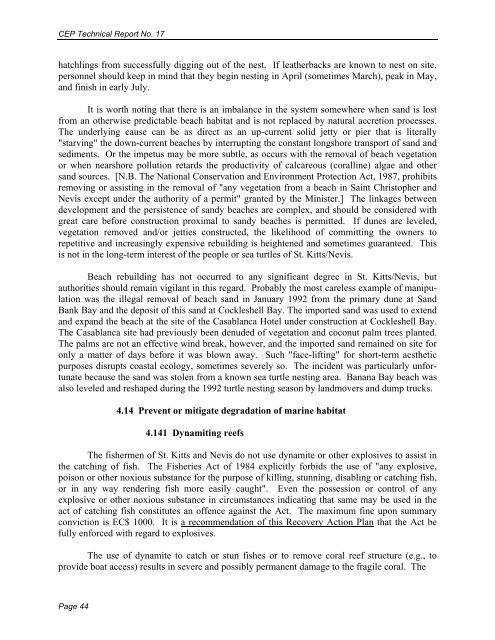Sea Turtle Recovery Action Plan for St. Kitts and Nevis - WIDECAST
Sea Turtle Recovery Action Plan for St. Kitts and Nevis - WIDECAST
Sea Turtle Recovery Action Plan for St. Kitts and Nevis - WIDECAST
Create successful ePaper yourself
Turn your PDF publications into a flip-book with our unique Google optimized e-Paper software.
CEP Technical Report No. 17<br />
hatchlings from successfully digging out of the nest. If leatherbacks are known to nest on site,<br />
personnel should keep in mind that they begin nesting in April (sometimes March), peak in May,<br />
<strong>and</strong> finish in early July.<br />
It is worth noting that there is an imbalance in the system somewhere when s<strong>and</strong> is lost<br />
from an otherwise predictable beach habitat <strong>and</strong> is not replaced by natural accretion processes.<br />
The underlying cause can be as direct as an up-current solid jetty or pier that is literally<br />
"starving" the down-current beaches by interrupting the constant longshore transport of s<strong>and</strong> <strong>and</strong><br />
sediments. Or the impetus may be more subtle, as occurs with the removal of beach vegetation<br />
or when nearshore pollution retards the productivity of calcareous (coralline) algae <strong>and</strong> other<br />
s<strong>and</strong> sources. [N.B. The National Conservation <strong>and</strong> Environment Protection Act, 1987, prohibits<br />
removing or assisting in the removal of "any vegetation from a beach in Saint Christopher <strong>and</strong><br />
<strong>Nevis</strong> except under the authority of a permit" granted by the Minister.] The linkages between<br />
development <strong>and</strong> the persistence of s<strong>and</strong>y beaches are complex, <strong>and</strong> should be considered with<br />
great care be<strong>for</strong>e construction proximal to s<strong>and</strong>y beaches is permitted. If dunes are leveled,<br />
vegetation removed <strong>and</strong>/or jetties constructed, the likelihood of committing the owners to<br />
repetitive <strong>and</strong> increasingly expensive rebuilding is heightened <strong>and</strong> sometimes guaranteed. This<br />
is not in the long-term interest of the people or sea turtles of <strong>St</strong>. <strong>Kitts</strong>/<strong>Nevis</strong>.<br />
Beach rebuilding has not occurred to any significant degree in <strong>St</strong>. <strong>Kitts</strong>/<strong>Nevis</strong>, but<br />
authorities should remain vigilant in this regard. Probably the most careless example of manipulation<br />
was the illegal removal of beach s<strong>and</strong> in January 1992 from the primary dune at S<strong>and</strong><br />
Bank Bay <strong>and</strong> the deposit of this s<strong>and</strong> at Cockleshell Bay. The imported s<strong>and</strong> was used to extend<br />
<strong>and</strong> exp<strong>and</strong> the beach at the site of the Casablanca Hotel under construction at Cockleshell Bay.<br />
The Casablanca site had previously been denuded of vegetation <strong>and</strong> coconut palm trees planted.<br />
The palms are not an effective wind break, however, <strong>and</strong> the imported s<strong>and</strong> remained on site <strong>for</strong><br />
only a matter of days be<strong>for</strong>e it was blown away. Such "face-lifting" <strong>for</strong> short-term aesthetic<br />
purposes disrupts coastal ecology, sometimes severely so. The incident was particularly un<strong>for</strong>tunate<br />
because the s<strong>and</strong> was stolen from a known sea turtle nesting area. Banana Bay beach was<br />
also leveled <strong>and</strong> reshaped during the 1992 turtle nesting season by l<strong>and</strong>movers <strong>and</strong> dump trucks.<br />
4.14 Prevent or mitigate degradation of marine habitat<br />
4.141 Dynamiting reefs<br />
The fishermen of <strong>St</strong>. <strong>Kitts</strong> <strong>and</strong> <strong>Nevis</strong> do not use dynamite or other explosives to assist in<br />
the catching of fish. The Fisheries Act of 1984 explicitly <strong>for</strong>bids the use of "any explosive,<br />
poison or other noxious substance <strong>for</strong> the purpose of killing, stunning, disabling or catching fish,<br />
or in any way rendering fish more easily caught". Even the possession or control of any<br />
explosive or other noxious substance in circumstances indicating that same may be used in the<br />
act of catching fish constitutes an offence against the Act. The maximum fine upon summary<br />
conviction is EC$ 1000. It is a recommendation of this <strong>Recovery</strong> <strong>Action</strong> <strong>Plan</strong> that the Act be<br />
fully en<strong>for</strong>ced with regard to explosives.<br />
The use of dynamite to catch or stun fishes or to remove coral reef structure (e.g., to<br />
provide boat access) results in severe <strong>and</strong> possibly permanent damage to the fragile coral. The<br />
Page 44
















